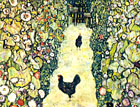Sowing Hollyhocks
Kathryn discovers that not only was Klimt an accomplished Art Nouveau painter, but was also completely obsessed with gardens and flowers.


A surprising new book has arrived: Gustav Klimt Landscapes, edited by Stephan Koja (Prestel, £12.99), and immediately its black-and-white endpapers catch my eye as much as the vividly colourful contents. Each one shows a different view of the painter standing in the garden beside his Viennese studio in 1910. Wearing his habitual kaftan-like, full-length smock and pointy slippers, grizzly bearded Klimt would not look out of place in a nativity scene, but his pose will be familiar to many gardeners. He stands in the garden transfixed, peering at unruly clumps of foliage under the wind-tousled leaves of overhanging trees. He seems, in fact, to be the object lesson for his contemporary, the Welsh poet William Henry Davies:
What is this life if, full of care,
We have no time to stand and stare.
No time to stand beneath the boughs
And stare as long as sheep or cows.
I had no idea that Klimt, famously the painter of emaciated Art Nouveau nudes and sinuous portraits awash with gold leaf, was also obsessed by flowers and gardens. Yet this charming book shows them to constitute a large and important strand of his work. His gardens are rural scenes with fruitful orchards; meadows awash with brilliant flowers; trees shimmering with the reflected light bouncing off thousands of leaves. Although the paintings have a graphic, two-dimensional quality, they convey at the same time the wonder that comes from absorbing natural forms. The ability to stand and stare.
At this time of year, when I step outdoors to stand and stare, it is to absorb the butter yellows of tenacious foliage still clinging to the trees, and to marvel at the number of things still flowering. But adjusting the gaze downwards brings one back to earth: there are reams of soggy leaves needing to be gathered and stored. We usually tumble them (and they must be wet) into black bin bags, which are then tied up and dispatched inside shrubby evergreenery where they won't be seen. Within six months to a year, the leaves will have rotted down into a wonderfully friable leaf mould, invaluable for fortifying hungry soil.
Exquisite houses, the beauty of Nature, and how to get the most from your life, straight to your inbox.
Some weeks ago I joined in a seed exchange held in a garden in southern France. Needless to say, most of the species being swapped with gusto that sunny autumn afternoon were plants that readily bask in the warmth of the Mediterranean. But then, more and more species previously thought of as 'too tender' for Britain are proving to survive and thrive here without a care. Even so, I passed on the Puyas and Aeoniums; declined Dasy-lirions and aloes; said non to Nolina and Norfolk Island pine. Instead, I carried away seeds of aromatic basils, strange tomatoes, hibiscus and, perhaps surprisingly, hollyhocks.
The usual advice is to sow hollyhock seeds under glass in late winter to ensure flowering by summer, or scattering the seeds in situ in mid-spring, with no certainty that they will manage to flower in the same year. Well, I'm going to scatter some in the garden right now, and raise some under glass as prescribed. It will be interesting to see whether there is any difference in performance between those which have to tough it out, and the mollycoddled ones.
My seed-swap hollyhocks are (apparently) single-flowered types, which I like, whereas British seed companies have for ages concentrated on the pom-pom, double-flowered kinds which lack any pretence to elegance. However, if you have also searched in vain for single-flowered strains, Chiltern Seeds (01229 581137; www.chilternseeds.co.uk) stocks several ranges, including the more unusual Alcea ficifolia from Siberia, and the near-black A. rosea Nigra. It also has A. rosea Simplex, the quintessential cottage garden hollyhock as painted by Helen Allingham, Beatrice Parsons and, as it happens, their forward-thinking and scandalous contemporary, Gustav Klimt.
It was rampant rust disease, with its unsightly pustules on the leaves, that killed off the gardener's love of hollyhocks in the years between the world wars, and they are still prone to it. The solution is to treat them as annuals or at most, biennials and pull out and burn the plants after flowering has finished, or after seeding if you want to collect your own.
This article first appeared in COUNTRY LIFE magazine on December 14, 2006
Country Life is unlike any other magazine: the only glossy weekly on the newsstand and the only magazine that has been guest-edited by His Majesty The King not once, but twice. It is a celebration of modern rural life and all its diverse joys and pleasures — that was first published in Queen Victoria's Diamond Jubilee year. Our eclectic mixture of witty and informative content — from the most up-to-date property news and commentary and a coveted glimpse inside some of the UK's best houses and gardens, to gardening, the arts and interior design, written by experts in their field — still cannot be found in print or online, anywhere else.
